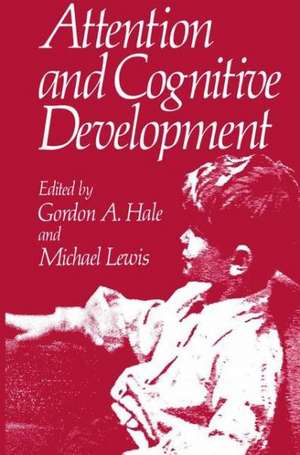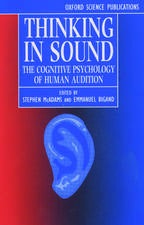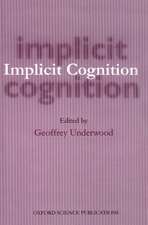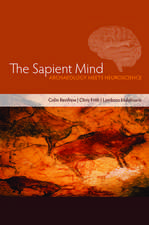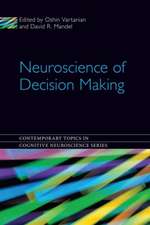Attention and Cognitive Development
Editat de G. Haleen Limba Engleză Paperback – 5 oct 2011
Preț: 393.13 lei
Nou
Puncte Express: 590
Preț estimativ în valută:
75.25€ • 81.76$ • 63.25£
75.25€ • 81.76$ • 63.25£
Carte tipărită la comandă
Livrare economică 19 aprilie-03 mai
Preluare comenzi: 021 569.72.76
Specificații
ISBN-13: 9781461329879
ISBN-10: 1461329876
Pagini: 384
Ilustrații: XVI, 366 p.
Dimensiuni: 155 x 235 x 20 mm
Greutate: 0.54 kg
Ediția:Softcover reprint of the original 1st ed. 1979
Editura: Springer Us
Colecția Springer
Locul publicării:New York, NY, United States
ISBN-10: 1461329876
Pagini: 384
Ilustrații: XVI, 366 p.
Dimensiuni: 155 x 235 x 20 mm
Greutate: 0.54 kg
Ediția:Softcover reprint of the original 1st ed. 1979
Editura: Springer Us
Colecția Springer
Locul publicării:New York, NY, United States
Public țintă
ResearchCuprins
1 Attention: The Perceiver as Performer.- Some Examples of Attending.- What Is Attention?.- What Attention Is Not.- Restatement of the Theme.- Classic Variables of Attention.- Expectation.- How Does Attention Develop?.- Conclusion.- References.- 2 The Concept of Identity and Children’s Selective Attention.- Extent of Visual Scanning.- Relevance of Perceived Differences to Judgments of Identity.- Criteria of Identity Judgments and Scanning Strategies.- Conclusion.- References.- 3 Development of Children’s Attention to Stimulus Components.- The Component Selection Task.- Development of Children’s Disposition toward Selectivity.- Development of Flexibility in Attention to Components.- A Further Issue in Measuring Attention to Components: Dimension Preferences.- Concluding Remarks.- References.- 4 A Constructivist Account of the Development of Perception, Attention, and Memory.- The Thesis.- Empirical and Theoretical Underpinnings.- A General, Unified Cognitive System?.- Concluding Remarks.- References.- 5 Stimulus Dimensions, Problem Solving, and Piaget.- Developmental Relationships between Conservation and Attention to Dimensions.- How Attention to Dimensions Affects Conservation Performance.- Implications for an Understanding of the Development of Dimensionalization.- Summary.- References.- 6 Developmental Aspects of Selective Orientation.- From Selective Orienting to Mental Representation.- Orienting Asymmetry and the Development of Handedness.- Effect of Rightward Response Bias on Lateral Attending.- Task-Related Attentional Biases.- References.- 7 Attentional Processes and Individual Differences.- A Review of Models of Attention and Memory.- Individual Differences in Information Processing.- Conclusion.- References.- 8 Toward a Clearer Definition of theAttentional Deficit of Hyperactive Children.- Confusion Caused by Current Diagnostic Labels.- Confusion Caused by Definitions of Attention.- Selective Attention as Defined in Studies of Stimulus Reduction, Distraction, and Incidental Learning.- Sustained Attention as Defined in Vigilance Studies.- Sustained Attention as Defined in Studies of More Complex Perceptual and Conceptual Processes: A Brief Review.- References.- 9 The Cognitive Effects of Stimulant Drugs on Hyperactive Children.- Definition of the Disorder.- Background Information on Drug Treatment.- Evaluation of Diagnostic Drug Trials.- Experiments Using Paired-Associate Learning.- Other Laboratory Tests.- Problems with Drug Treatment.- Directions for Future Research.- References.- 10 Attention and Cognitive Style in Children.- The Confounding of Cognitive Style and Development.- Attention and Cognitive Style: A Developmental Lag Approach.- Style: Individual Differences in Attention Deployment.- Attention and Cognitive Style: The Developmental Lag Interpretation Reevaluated.- Cognitive Styles: Separate but Unequal?.- A Word of Caution.- References.- 11 Attention in the Classroom.- Alertness.- Selectivity.- Central Processing.- Monitoring and Fostering Attention in the Classroom.- Special Problems of Attention.- Summary.- References.- 12 Watching Children Watch Television.- When Children Begin to Watch Television.- Amount of Television Viewing.- Factors Related to Amount of Home Viewing.- Visual Attention to Television.- Attributes of Television Programs That Influence Visual Attention.- Discussion of the Attribute Effects.- Auditory Attention to Television.- A Possible Theoretical Direction for Future Research on Attention to Television.- Final Comments.- References.
